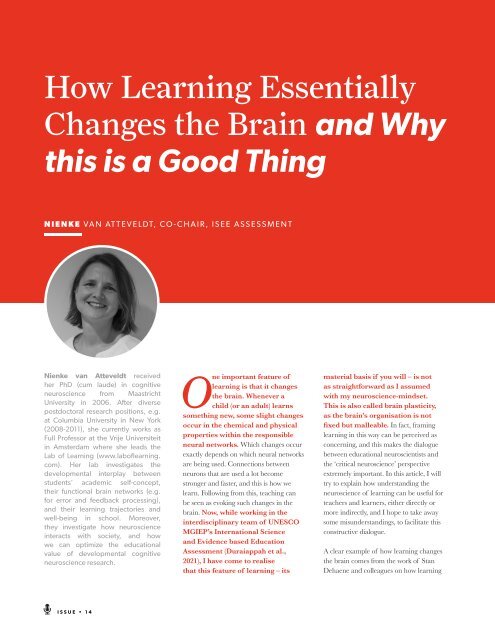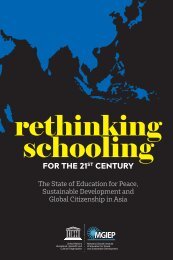The Blue DOT 14 - Multidisciplinary Science & Evidence For Education
Welcome to the 14th edition of the Institute’s flagship publication, The Blue DOT. In this edition, we bring to you news of the International Science and Evidence-based Education Assessment (ISEE Assessment) that the Institute embarked on about 18 months ago. The International Science and Evidence-based Education (ISEE) Assessment contributes to re-envisioning the future of education and feeds into UNESCO's Futures of Education report, today constituting over 250 authors from 70 countries. Read Opinion Pieces by thought-leaders, experts and academics, watch interviews with our advisory board members and explore the learnings of our research fellows while navigating experience of the Multidisciplinary Science & Evidence for Education.
Welcome to the 14th edition of the Institute’s flagship publication, The Blue DOT. In this edition, we bring to you news of the International Science and Evidence-based Education Assessment (ISEE Assessment) that the Institute embarked on about 18 months ago. The International Science and Evidence-based Education (ISEE) Assessment contributes to re-envisioning the future of education and feeds into UNESCO's Futures of Education report, today constituting over 250 authors from 70 countries. Read Opinion Pieces by thought-leaders, experts and academics, watch interviews with our advisory board members and explore the learnings of our research fellows while navigating experience of the Multidisciplinary Science & Evidence for Education.
Create successful ePaper yourself
Turn your PDF publications into a flip-book with our unique Google optimized e-Paper software.
How Learning Essentially<br />
OPINION<br />
Changes the Brain and Why<br />
this is a Good Thing<br />
NIENKE VAN ATTEVELDT, CO-CHAIR, ISEE ASSESSMENT<br />
Nienke van Atteveldt received<br />
her PhD (cum laude) in cognitive<br />
neuroscience from Maastricht<br />
University in 2006. After diverse<br />
postdoctoral research positions, e.g.<br />
at Columbia University in New York<br />
(2008-2011), she currently works as<br />
Full Professor at the Vrije Universiteit<br />
in Amsterdam where she leads the<br />
Lab of Learning (www.laboflearning.<br />
com). Her lab investigates the<br />
developmental interplay between<br />
students’ academic self-concept,<br />
their functional brain networks (e.g.<br />
for error and feedback processing),<br />
and their learning trajectories and<br />
well-being in school. Moreover,<br />
they investigate how neuroscience<br />
interacts with society, and how<br />
we can optimize the educational<br />
value of developmental cognitive<br />
neuroscience research.<br />
One important feature of<br />
learning is that it changes<br />
the brain. Whenever a<br />
child (or an adult) learns<br />
something new, some slight changes<br />
occur in the chemical and physical<br />
properties within the responsible<br />
neural networks. Which changes occur<br />
exactly depends on which neural networks<br />
are being used. Connections between<br />
neurons that are used a lot become<br />
stronger and faster, and this is how we<br />
learn. Following from this, teaching can<br />
be seen as evoking such changes in the<br />
brain. Now, while working in the<br />
interdisciplinary team of UNESCO<br />
MGIEP’s International <strong>Science</strong><br />
and <strong>Evidence</strong> based <strong>Education</strong><br />
Assessment (Duraiappah et al.,<br />
2021), I have come to realise<br />
that this feature of learning – its<br />
material basis if you will – is not<br />
as straightforward as I assumed<br />
with my neuroscience-mindset.<br />
This is also called brain plasticity,<br />
as the brain’s organisation is not<br />
fixed but malleable. In fact, framing<br />
learning in this way can be perceived as<br />
concerning, and this makes the dialogue<br />
between educational neuroscientists and<br />
the ‘critical neuroscience’ perspective<br />
extremely important. In this article, I will<br />
try to explain how understanding the<br />
neuroscience of learning can be useful for<br />
teachers and learners, either directly or<br />
more indirectly, and I hope to take away<br />
some misunderstandings, to facilitate this<br />
constructive dialogue.<br />
A clear example of how learning changes<br />
the brain comes from the work of Stan<br />
Dehaene and colleagues on how learning<br />
to read transforms the brain. By comparing the brains of literate<br />
and illiterate people, they showed how profoundly the brain<br />
changes with reading instruction, both in visual and in languagerelated<br />
neural mechanisms (Dehaene et al., 2015). A relevant<br />
question is how such insights can be used to improve learning and<br />
teaching, and foster child development towards flourishing.<br />
A main challenge is that the conditions<br />
under which most neuroscience studies<br />
take place are not naturalistic, but rather,<br />
situated in artificial laboratory environments<br />
and tightly controlled to measure an<br />
isolated process.<br />
An example of neuroscience studies useful for education<br />
are neuroimaging studies that show a better prediction<br />
of learning difficulties, and of which treatment is effective<br />
for whom, over and above behavioural indicators (Gabrieli,<br />
2016). Moreover, neuroscience can contribute to our knowledge<br />
about what are optimal learning conditions, for example in terms<br />
of sleep, nutrition, etcetera (Thomas et al., 2020). More indirectly,<br />
insights in how the brain learns and develops can influence beliefs<br />
and attitudes. <strong>For</strong> example, a better understanding of protracted<br />
adolescent brain development may stimulate teachers to provide<br />
more guidance with planning or simply to be more patient and<br />
understanding. Similarly, a better understanding of individual<br />
differences (i.e., diversity) and learning disabilities may reduce<br />
stereotypes and negative attitudes.<br />
Clearly, there are also many challenges. A main challenge<br />
is that the conditions under which most neuroscience<br />
studies take place are not naturalistic, but rather,<br />
situated in artificial laboratory environments and tightly<br />
controlled to measure an isolated process. In other words,<br />
most studies suffer from low ‘ecological validity’, making it hard<br />
to translate the findings to real-life learning situations. Different<br />
approaches are being taken to include more realistic contexts in<br />
neuroscience studies (van Atteveldt et al., 2018). <strong>For</strong> example,<br />
developments in portable neuroimaging devices, such as mobile<br />
ISSUE • <strong>14</strong><br />
4 5

















